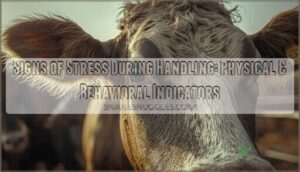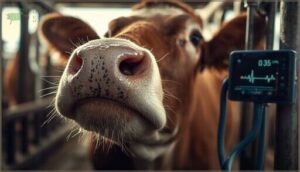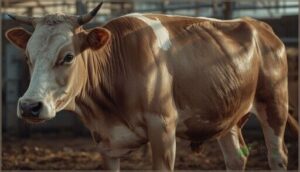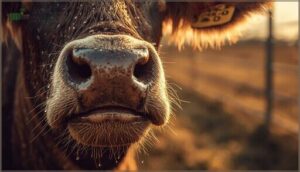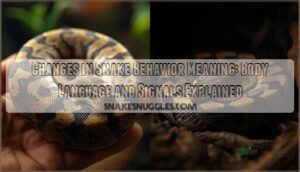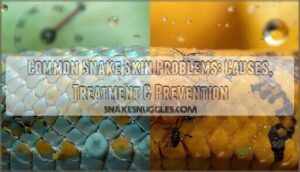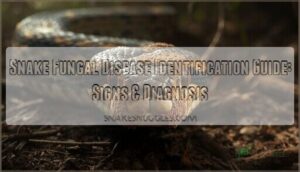This site is supported by our readers. We may earn a commission, at no cost to you, if you purchase through links.
A cow’s pupils dilate. Her nostrils flare. She shifts her weight backward, muscles tensing beneath her hide as a handler approaches with a halter. These subtle physiological shifts—often dismissed as mere temperament—represent a cascade of stress responses that can compromise both animal welfare and handler safety.
Recognizing signs of stress during handling isn’t just about reading body language; it’s about understanding the biological mechanisms that drive fear-based reactions in livestock. When animals experience handling stress, their cortisol levels spike, heart rates accelerate, and decision-making shifts from cognitive processing to instinctive survival mode.
The challenge lies in distinguishing normal alertness from genuine distress, and knowing which physical and behavioral indicators warrant immediate intervention to prevent escalation.
Table Of Contents
Key Takeaways
- Stress in livestock handling triggers measurable physiological changes—cortisol spikes within 10–40 minutes, heart rates can increase by 130% in sheep, and respiratory rates in cattle can jump from 30–40 to 70 breaths per minute—making these physical indicators your most reliable early warning system before behavioral changes become apparent.
- Low-stress handling techniques deliver concrete economic benefits, with acclimated cattle gaining 8% more weight (2.92 vs 2.70 lb/day) and operations reporting 5–7% lower production costs, while eliminating electric prods and working with small groups prevents both immediate distress and long-term chronic stress that compromises immune function.
- Past handling experiences permanently shape future stress responses—cattle with a calm handling history show lower cortisol and heart rates during restraint, while those exposed to rough treatment or electric prods display heightened defensive behaviors and elevated stress hormones in subsequent encounters.
- Facility design directly impacts stress outcomes as much as handling technique, with proper ventilation reducing dust by 50%, adequate space allocation (35-45 sq ft per cow-calf pair) decreasing aggression by 40%, and curved alleyways with guide rails enabling natural movement patterns that lower cortisol levels.
What is Stress During Handling?
When you handle livestock, you’re asking them to do something that doesn’t feel natural—moving through unfamiliar spaces, being restrained, or interacting with humans in close quarters. Stress during these moments is their body’s way of responding to perceived threats, whether real or imagined.
To recognize and reduce that stress, you first need to understand what it’s, what triggers it, and how their systems react in both the short and long term.
Definition of Stress in Livestock Handling
Stress physiology in livestock handling describes your animal’s biological response when environmental or management challenges disrupt its equilibrium and tax its control systems.
Animal welfare frameworks distinguish stress—where cattle adapt successfully—from distress, which occurs when coping fails and behavioral responses, health, and farm management outcomes suffer. Understanding this distinction helps you recognize when handling practices compromise cattle stress management and cattle health.
The impact of handling on cattle can be understood through studying stress response mechanisms.
Causes of Stress During Handling Events
Multiple factors during handling events trigger cattle stress and compromise animal welfare. Understanding these causes helps improve handling practices and cattle health.
Common stressors include:
- Human interaction patterns: Rough handling with electric prods increases cortisol by 50%, while inconsistent handlers boost stress hormones
- Noise pollution and unfamiliar facilities: Sudden sounds spike heart rate 20–30%
- Restraint and handling equipment: Physical restraint rapidly elevates cortisol, especially in Bos indicus cattle
- Space allocation problems: Overcrowding boosts agitation behaviors by 40% and increases injuries
- Animal socialization disruptions: Mixing unfamiliar cattle raises stress markers 28% through social instability
These factors directly impact stress management outcomes and cattle stress levels across operations. Effective management of animal stress factors is vital to improve animal welfare and reduce economic losses.
Acute Vs. Chronic Stress Responses
When you understand how cattle respond to handling, you’ll notice two distinct patterns. Acute stress hits fast—cortisol peaks within 10–40 minutes, heart rate spikes, and cattle show immediate restlessness. Recovery usually takes 3–7 days. Chronic stress, however, stems from repeated exposure, causing persistent physiological changes, depressed behavior, and compromised immune function that demands longer recovery periods and threatens animal welfare.
| Stress Type | Key Characteristics |
|---|---|
| Acute Stress | Cortisol peaks in 10–40 minutes; heart rate correlates with stress hormones (r=0.80); rapid behavioral adaptation with flight responses |
| Chronic Stress | Sustained elevation of stress hormones; immune suppression; persistent behavioral changes like increased latency to eat (7–30 days) |
| Recovery Patterns | Acute: 3–7 days to baseline; Chronic: slower return to homeostasis with prolonged metabolic alterations |
| Behavioral Symptoms | Acute: vocalization, restlessness; Chronic: excessive grooming, social withdrawal, learned helplessness |
| Health Outcomes | Acute: temporary reduction in productivity; Chronic: compromised disease resistance, reduced vaccine efficacy, digestive disturbances requiring stress mitigation strategies |
Physical Signs of Stress in Animals
When you’re working with animals, their bodies tell the story before their behavior does. Physical signs of stress appear quickly during handling—often within seconds—and they’re your most reliable early warning system.
An animal’s body reveals stress within seconds—long before behavior changes—making physical signs your first and most reliable alert
Let’s look at the key physiological indicators you’ll need to recognize in real time.
Changes in Heart Rate and Breathing
When animals face handling events, their cardiovascular and respiratory systems react immediately. Heart rate monitoring reveals dramatic spikes—sheep can see increases of nearly 130%, while dairy cows show rises of 15–22 beats per minute.
Breathing patterns shift equally: respiratory changes in cattle escalate from 30–40 breaths per minute to 70 during acute stress. These cardiac responses and stress physiology markers provide you with measurable, objective indicators of distress.
Muscle Tension and Trembling
Tension manifests through observable neuromuscular control changes during handling. You’ll notice rigid postures and elevated muscle tone—surface electromyography studies document amplitude increases exceeding 26% in facial muscles under acute cattle stress.
Trembling follows as a physiological reaction: over 42% of distressed animals display generalized tremors, serving as functional stress discharge mechanisms.
These stress symptoms demand immediate attention for animal welfare and effective stress management in your operation.
Panting, Sweating, and Salivation
Thermoregulatory shifts trigger three measurable indicators: respiratory rates escalate during thermal stress—heat-susceptible cattle average panting scores of 1.22 versus 0.94 in tolerant animals. Sweat patterns intensify when ambient temperatures exceed 32°C, activating evaporative heat mitigation mechanisms.
Saliva analysis reveals elevated cortisol concentrations following handling stress, providing quantitative biomarkers for cattle stress assessment.
These physiological responses directly impact cattle health and welfare, requiring proactive stress management protocols in your operation.
Digestive Disturbances and Weight Loss
Stress-driven disruptions in gut health issues compromise your cattle’s digestive function through measurable pathways. Feed intake reduction accompanies elevated cortisol—stressed animals consume less, slowing weight gain by up to 30%.
Intestinal damage from barrier breakdown impairs nutrient absorption, triggering nutritional deficiencies despite adequate livestock nutrition programs.
Weight loss patterns manifest quickly: cattle shrink 3–9% during transport, with digestive problems persisting for days post-handling, directly affecting animal welfare and profitability.
Behavioral Indicators of Stress
While physical symptoms reveal how an animal’s body reacts to handling stress, behavioral changes often provide the clearest early warning signs that something’s wrong. You’ll notice these indicators before many physiological symptoms become apparent, making them essential for real-time stress assessment.
The most common behavioral responses during handling include vocalization patterns, escape attempts, defensive reactions, and repetitive self-soothing behaviors.
Vocalization and Restlessness
When you hear cattle calling out or see them pacing during handling, you’re witnessing direct acoustic analysis of their stress levels. Vocalization intensity correlates with cortisol elevation, while restlessness scores quantify agitation severity—both critical for welfare impacts assessment.
Key behavioral triggers demanding your attention:
- Electric prodding causes over half of stress vocalizations in beef plants
- Closed-mouth calls represent 53.6% of post-calving stress responses
- Foot-lifting occurs in 33% of milkings, escalating with somatic cell count
- Acceptable vocalization benchmarks remain at 3% or less for ideal cattle stress management
Attempts to Escape or Avoidance
You’ll recognize escape behavior when cattle consistently retreat, hesitate entering chutes, or bolt during restraint. Nguni cattle demonstrate more active avoidance strategies than Boran breeds, with entry times doubling from 2 to 4.5 minutes across repeated handling sessions.
These flight responses signal stress triggers you can’t ignore—cattle requiring physical force show elevated cortisol levels, marking clear evasion techniques that compromise both animal welfare and operational efficiency in stress management protocols.
Aggression or Defensive Behaviors
When cattle kick, butt, or charge during handling, you’re witnessing defensive mechanisms triggered by acute stress—commercial operations report up to 10% reductions in premium carcass quality from these aggressive behavior patterns. Recognizing these stress triggers protects both animal welfare and handler safety.
- Animals with heightened cortisol show faster exit speeds and increased agitation during restraint
- Negative handling techniques like shouting or hitting intensify defensive responses in subsequent sessions
- Defensive cattle demonstrate measurable productivity losses alongside compromised stress management outcomes
Excessive Grooming or Licking
While defensive aggression signals immediate distress, you’ll also notice quieter coping mechanisms—like excessive grooming or licking—that reveal handling stress in cattle behavior.
These repetitive behaviors emerge when animals attempt to self-soothe during or after stressful handling events. Research links such licking disorders to elevated cortisol and compromised animal welfare, making them critical stress triggers to monitor in your stress management strategies.
Environmental and Management Stressors
Stress doesn’t happen in a vacuum—the physical environment and how you manage your animals play a massive role in how they experience handling events. Everything from the design of your facilities to the weather conditions on any given day can either buffer stress or heighten it dramatically.
Let’s look at three critical environmental and management factors that directly influence stress levels during handling.
Effects of Overcrowding and Handling Facilities
Space allocation shapes every moment your animals spend in handling facilities. When cattle face inadequate facility layout or excessive stocking rates, you’ll observe doubled injury risk and compromised animal behavior and welfare.
Overcrowding triggers resource competition, elevating animal density beyond ideal livestock operations thresholds. Strategic handling systems design and proper stress management strategies reduce these pressures, supporting both cattle stress reduction and operational efficiency throughout your facility.
Impact of Temperature and Weather
Temperature extremes profoundly influence animal behavior and welfare during handling events. You’ll notice heat stress emerging when the temperature-humidity index reaches 68.8, with cattle stress escalating as thermal comfort declines. Weather extremes—from summer heat to cold exposure—alter livestock operations outcomes markedly.
- Cold stress increases metabolic demands and vulnerability in thin-hided breeds
- Climate change extends duration and intensity of temperature-related handling challenges
- Panting and restlessness signal thermal discomfort during movement through facilities
- Winter mortality rates rise substantially, particularly affecting young calves
Handling Techniques and Restraint Methods
Beyond environmental conditions, your choice of restraint devices and handling tools directly shapes animal welfare outcomes. Manual squeeze chutes dominate over half of operations, yet poorly designed equipment requiring over 30 seconds to restrain cattle elevates cortisol sharply. Low-stress handling techniques—patient, behavior-centered approaches with minimal force—reduce fear responses and improve cattle stress indicators. Conveyorized systems allowing visual contact between animals maintain calmer livestock than isolated restraints.
| Restraint Type | Adoption Rate | Welfare Impact |
|---|---|---|
| Manual squeeze chutes | >50% of operations | Standard baseline stress |
| Hydraulic headgates | 24.49% of farms | Reduced handling time |
| Conveyorized systems | Limited adoption | Calmer, lower cortisol |
Facility design improvements—curved alleyways, guide rails, adequate space (35-45 sq ft per cow-calf pair)—enable natural movement and reduce both physical symptoms like trembling and behavioral symptoms, including vocalization. Staff training in positive reinforcement correlates with 96.4% correct application of humane practices, demonstrating that stress management depends equally on equipment quality and handler skill.
Monitoring and Reducing Handling Stress
Once you recognize the signs of stress, the next step is putting that knowledge into action. Reducing handling stress isn’t about a single fix—it requires a combination of careful observation, thoughtful facility design, proper techniques, and well-trained personnel.
Let’s look at the key strategies that will help you create a calmer, safer handling experience for your animals.
Observation and Record-Keeping
You can’t manage what you don’t measure—that’s where observation and record systems become your most powerful management tools for stress monitoring. Consistent observation methods paired with reliable record systems enable you to detect subtle behavioral symptoms and physical symptoms before they escalate. Effective data analysis transforms raw observations into actionable insights for managing stress across your entire operation.
Consider implementing these proven observation methods:
- Conduct visual checks at least twice daily to catch early stress symptoms
- Document handling events with timestamps and behavioral responses
- Use RFID or automated systems to track individual feeding patterns continuously
- Record environmental conditions during documented stress episodes
- Maintain standardized logs to enable meaningful data analysis over time
Canadian producers conducting daily checks reduced calf mortality by up to 34%, while automated monitoring systems detected health changes 30% faster than conventional methods. Your observation records provide the foundation for evidence-based decisions—farms using detailed documentation reported an 18% reduction in overall stress indicators within one year.
Low-Stress Handling Techniques
Moving cattle with patience rather than force transforms your entire operation. Acclimated animals gained 2.92 lb/day versus 2.70 lb/day with conventional methods, an 8% improvement protecting both cattle welfare and farm management economics. You’ll reduce behavioral symptoms like vocalization while preventing physical symptoms of chronic stress. Eliminating electric prods and working with small groups at a time proves essential for stress prevention and improved animal behavior.
Training in proper animal handling techniques requires an initial time investment but delivers measurable stress management benefits. Operations report 5–7% lower production costs through reduced disease pressure and enhanced weight gain outcomes.
| Handling Tools to Remove | Low-Stress Alternatives |
|---|---|
| Electric prods | Flags and sorting paddles |
| Shouting and rushing | Calm movement, quiet voices |
| Large group processing | Small batches (5–10 animals) |
| Tight restraint | Natural herding flow |
Facility Design and Environmental Improvements
Your facility’s physical design shapes stress levels as profoundly as any handling technique. Strategic environmental improvements protect welfare standards and livestock production outcomes simultaneously.
- Ventilation systems: Install recirculating units achieving 5+ air exchanges hourly to reduce dust concentrations by over 50% and improve air quality.
- Lighting design: Deploy dimmable LED systems throughout handling areas to encourage calmer behavior during processing.
- Noise reduction: Eliminate metal clanging and shouting, which increase heart rates and trigger fear responses in cattle.
- Temperature control: Provide shade structures offering 3 m² per head to mitigate heat stress and reduce respiration rates.
- Space allocation: Increase per-animal space to decrease aggression and prevent cold stress during winter housing.
Training Staff for Stress Recognition
You can’t expect your team to identify what they haven’t been taught to see. Staff Training Methods grounded in Animal Behavior Analysis provide the foundation for recognizing both Physical Symptoms—trembling, elevated heart rates—and Behavioral Symptoms like vocalizations during handling.
Stress Awareness Programs incorporating Handling Technique Optimization and Training Evaluation Tools improve stress recognition accuracy by 35%, directly enhancing Stress Management outcomes and reducing the need for reactive Veterinary Care interventions.
Frequently Asked Questions (FAQs)
How does prior handling experience affect stress responses?
Like the old saying goes, “you can’t unring a bell”—past experiences shape how animals react today.
Cattle with calm handling history show lower cortisol and heart rates during restraint, while those with negative handling display heightened stress responses and defensive behaviors.
Can stress during handling impact meat quality permanently?
Yes, chronic handling stress permanently degrades meat quality through glycogen depletion, elevating pH above 8 and creating dark, firm, dry beef. You can’t reverse this damage post-slaughter, making stress mitigation essential.
Do different breeds respond differently to handling stress?
Absolutely. Genetic factors shape how cattle perceive threats—Bos indicus breeds exhibit heightened behavioral symptoms and cortisol spikes during restraint compared to calmer Bos taurus lines, requiring customized handling techniques and temperament testing for maximum stress resilience.
What role does handler attitude play in stress?
Handler attitude profoundly influences animal stress levels. A calm, empathetic approach directly reduces behavioral symptoms like vocalization and physical symptoms, including elevated cortisol.
Positive human-animal bonds improve animal welfare, while confident handling enhances stress management outcomes.
How quickly do stress levels return to normal?
Recovery timeframes vary surprisingly—your animal’s hormonal recovery happens fastest, with cortisol normalization in 2–3 hours post-handling, while behavioral indicators and stress symptoms may persist longer depending on individual temperament and management practices.
Conclusion
The stakes of misreading stress aren’t just high—they’re handling dependent. When you sharpen your ability to interpret signs of stress during handling, you transform unpredictable situations into manageable ones.
Those dilated pupils, backward weight shift, accelerated breathing—they’re not obstacles but opportunities for intervention. Your vigilance becomes the bridge between reactive chaos and proactive calm, protecting both the animals in your care and the handlers who work alongside them daily.
- https://www.grandin.com/references/reduce.hand.stress.html
- https://pmc.ncbi.nlm.nih.gov/articles/PMC4536120/
- https://familyveterinaryinc.com/blog-los-angeles-sherman-oaks-beverly-hills/identifying-stress-in-your-pet-how-to-recognize-the-signs-and-why-it-matters
- https://vcahospitals.com/know-your-pet/signs-your-dog-is-stressed-and-how-to-relieve-it
- https://inaroadanimalhospital.com/the-surprising-connection-between-human-stress-and-pet-behavior/

